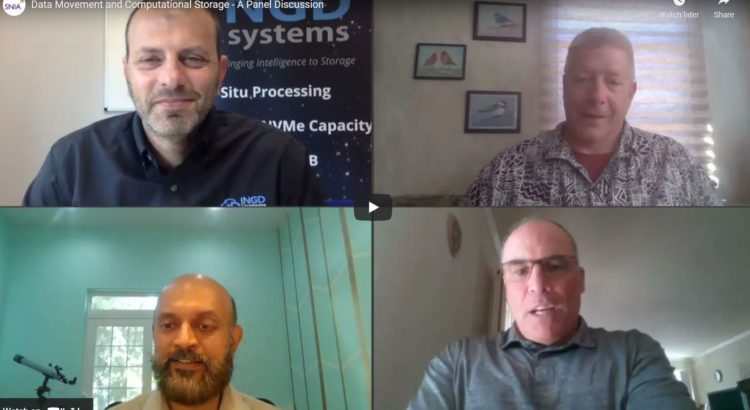 specification and ecosystem are growing in scope to include full enablement and alignment for NVMe® and NVMe-oF client workloads and use cases. By partnering with other industry-standard organizations including DMTF®, NVM Express, and OpenFabrics Alliance (OFA), SNIA’s Scalable Storage Management Technical Work Group has updated the Swordfish bundles from version 1.2.1 and later to cover an expanding range of NVMe and NVMe-oF functionality including NVMe device management and storage fabric technology management and administration.
The Need
Large-scale computing designs are increasingly multi-node and linked together through high-speed networks. These networks may be comprised of different types of technologies, fungible, and morphing. Over time, many different types of high-performance networking devices will evolve to participate in these modern, coupled-computing platforms. New fabric management capabilities, orchestration, and automation will be required to deploy, secure, and optimally maintain these high-speed networks. Read More
specification and ecosystem are growing in scope to include full enablement and alignment for NVMe® and NVMe-oF client workloads and use cases. By partnering with other industry-standard organizations including DMTF®, NVM Express, and OpenFabrics Alliance (OFA), SNIA’s Scalable Storage Management Technical Work Group has updated the Swordfish bundles from version 1.2.1 and later to cover an expanding range of NVMe and NVMe-oF functionality including NVMe device management and storage fabric technology management and administration.
The Need
Large-scale computing designs are increasingly multi-node and linked together through high-speed networks. These networks may be comprised of different types of technologies, fungible, and morphing. Over time, many different types of high-performance networking devices will evolve to participate in these modern, coupled-computing platforms. New fabric management capabilities, orchestration, and automation will be required to deploy, secure, and optimally maintain these high-speed networks. Read More
How SNIA Swordfish™ Expanded with NVMe® and NVMe-oF™
The SNIA Swordfish specification and ecosystem are growing in scope to include full enablement and alignment for NVMe® and NVMe-oF client workloads and use cases. By partnering with other industry-standard organizations including DMTF®, NVM Express, and OpenFabrics Alliance (OFA), SNIA’s Scalable Storage Management Technical Work Group has updated the Swordfish bundles from version 1.2.1 and later to cover an expanding range of NVMe and NVMe-oF functionality including NVMe device management and storage fabric technology management and administration.
The Need
Large-scale computing designs are increasingly multi-node and linked together through high-speed networks. These networks may be comprised of different types of technologies, fungible, and morphing. Over time, many different types of high-performance networking devices will evolve to participate in these modern, coupled-computing platforms. New fabric management capabilities, orchestration, and automation will be required to deploy, secure, and optimally maintain these high-speed networks. Read More
specification and ecosystem are growing in scope to include full enablement and alignment for NVMe® and NVMe-oF client workloads and use cases. By partnering with other industry-standard organizations including DMTF®, NVM Express, and OpenFabrics Alliance (OFA), SNIA’s Scalable Storage Management Technical Work Group has updated the Swordfish bundles from version 1.2.1 and later to cover an expanding range of NVMe and NVMe-oF functionality including NVMe device management and storage fabric technology management and administration.
The Need
Large-scale computing designs are increasingly multi-node and linked together through high-speed networks. These networks may be comprised of different types of technologies, fungible, and morphing. Over time, many different types of high-performance networking devices will evolve to participate in these modern, coupled-computing platforms. New fabric management capabilities, orchestration, and automation will be required to deploy, secure, and optimally maintain these high-speed networks. Read More
 specification and ecosystem are growing in scope to include full enablement and alignment for NVMe® and NVMe-oF client workloads and use cases. By partnering with other industry-standard organizations including DMTF®, NVM Express, and OpenFabrics Alliance (OFA), SNIA’s Scalable Storage Management Technical Work Group has updated the Swordfish bundles from version 1.2.1 and later to cover an expanding range of NVMe and NVMe-oF functionality including NVMe device management and storage fabric technology management and administration.
The Need
Large-scale computing designs are increasingly multi-node and linked together through high-speed networks. These networks may be comprised of different types of technologies, fungible, and morphing. Over time, many different types of high-performance networking devices will evolve to participate in these modern, coupled-computing platforms. New fabric management capabilities, orchestration, and automation will be required to deploy, secure, and optimally maintain these high-speed networks. Read More
specification and ecosystem are growing in scope to include full enablement and alignment for NVMe® and NVMe-oF client workloads and use cases. By partnering with other industry-standard organizations including DMTF®, NVM Express, and OpenFabrics Alliance (OFA), SNIA’s Scalable Storage Management Technical Work Group has updated the Swordfish bundles from version 1.2.1 and later to cover an expanding range of NVMe and NVMe-oF functionality including NVMe device management and storage fabric technology management and administration.
The Need
Large-scale computing designs are increasingly multi-node and linked together through high-speed networks. These networks may be comprised of different types of technologies, fungible, and morphing. Over time, many different types of high-performance networking devices will evolve to participate in these modern, coupled-computing platforms. New fabric management capabilities, orchestration, and automation will be required to deploy, secure, and optimally maintain these high-speed networks. Read More








